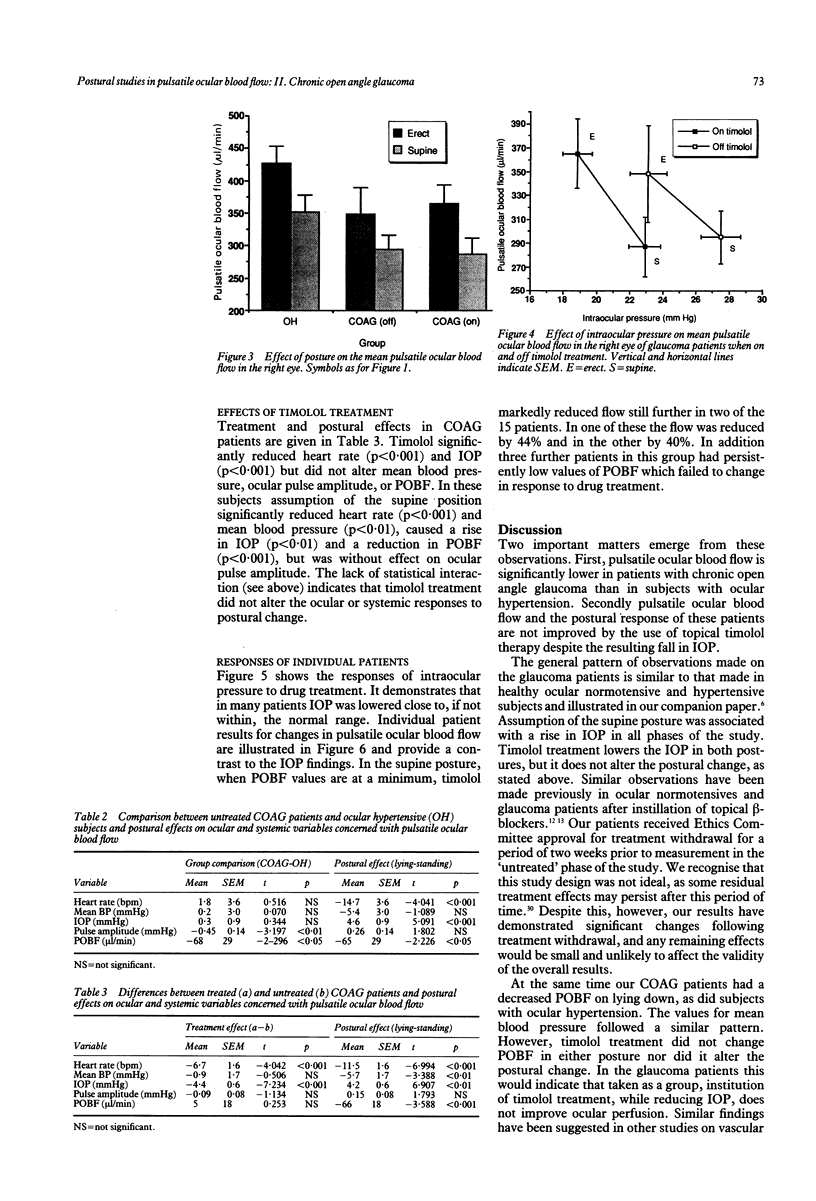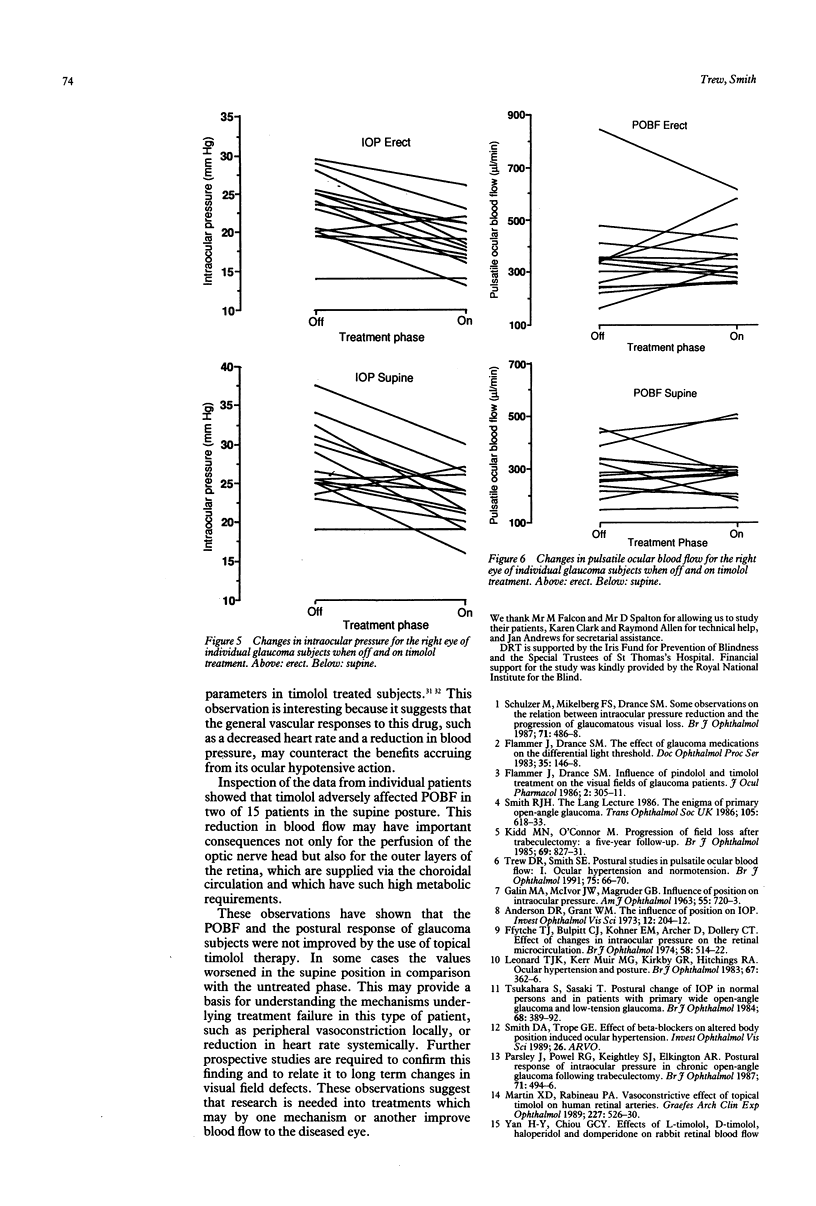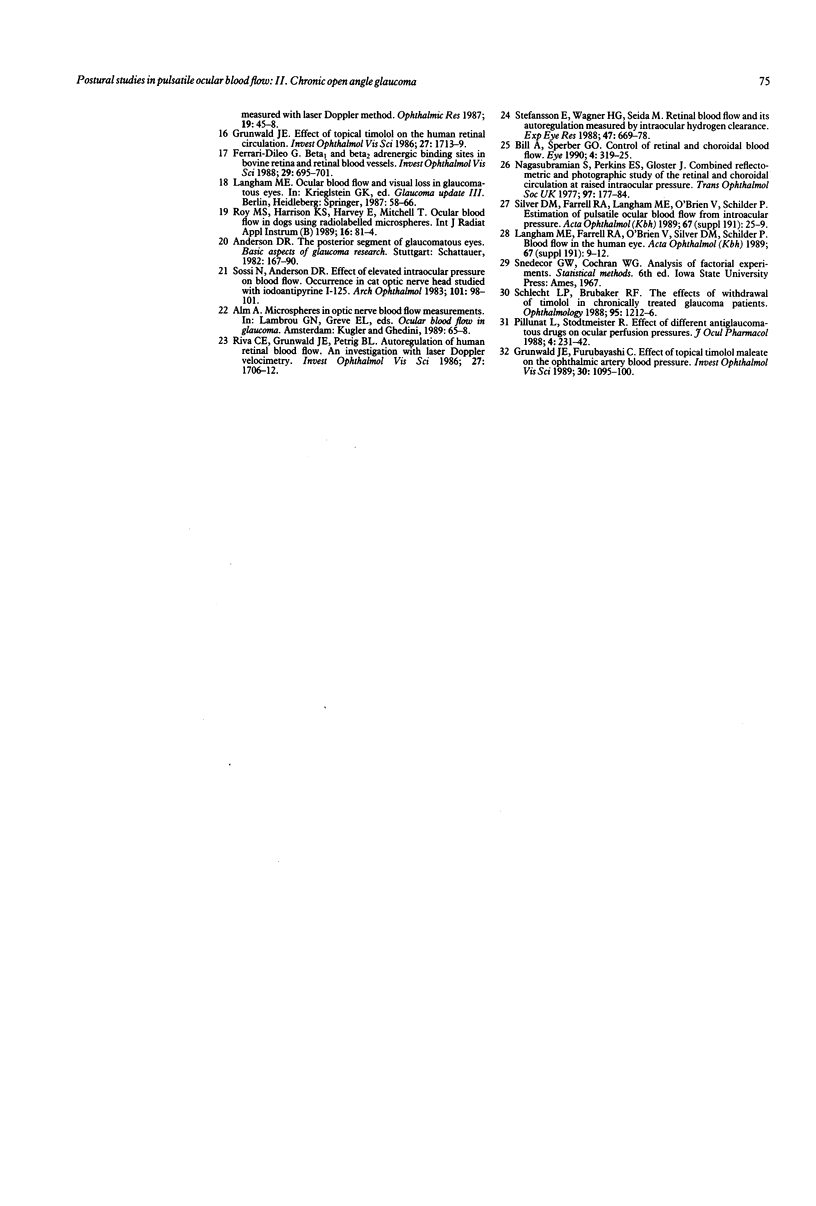Abstract
The pulsatile ocular blood flow (POBF) has been recorded in 15 patients with chronic open angle glaucoma. Measurements were performed during regular treatment with timolol 0.25% eyedrops, two weeks after withdrawal of this treatment, and then a further two weeks after its reinstitution. Readings were taken with subjects in both the erect and supine positions by means of a pneumotonometric probe to measure intraocular pressure (IOP), linked to a Langham ocular blood flow system. Assumption of the supine posture was associated with a significant increase in IOP in all phases of the study. Treatment with timolol lowered the mean IOP in comparison with the untreated phase (-4.4 (SEM 0.6) mmHg, p less than 0.001) but had no effect on the postural change. A significant reduction in POBF was recorded on assumption of the supine posture (-66 (SEM 18) microliters/min, p less than 0.001), representing a mean decrement of 19%. However, there were no significant differences in POBF between treated and untreated phases of the study. Comparison of the values obtained in patients with glaucoma (COAG) after withdrawal of treatment with those in subjects with ocular hypertension revealed that there was no significant difference in intraocular pressure between the two groups. However, both POBF (-68 (SEM 29) microliters/min) and the pulse amplitude of the intraocular pressure (ocular pulse: -0.45 (SEM) 0.14 mmHg) were significantly lower in the COAG patients. Pulsatile ocular blood flow is significantly lower in patients with chronic open angle glaucoma. Furthermore, the POBF and the postural response of these patients is not improved by the use of topical timolol therapy.
Full text
PDF




Selected References
These references are in PubMed. This may not be the complete list of references from this article.
- Anderson D. R., Grant W. M. The influence of position on intraocular pressure. Invest Ophthalmol. 1973 Mar;12(3):204–212. [PubMed] [Google Scholar]
- Bill A., Sperber G. O. Control of retinal and choroidal blood flow. Eye (Lond) 1990;4(Pt 2):319–325. doi: 10.1038/eye.1990.43. [DOI] [PubMed] [Google Scholar]
- Ferrari-Dileo G. Beta 1 and beta 2 adrenergic binding sites in bovine retina and retinal blood vessels. Invest Ophthalmol Vis Sci. 1988 May;29(5):695–699. [PubMed] [Google Scholar]
- Ffytche T. J., Bulpitt C. J., Kohner E. M., Archer D., Dollery C. T. Effect of changes in intraocular pressure on the retinal microcirculation. Br J Ophthalmol. 1974 May;58(5):514–522. doi: 10.1136/bjo.58.5.514. [DOI] [PMC free article] [PubMed] [Google Scholar]
- Flammer J., Robert Y., Gloor B. Influence of pindolol and timolol treatment on the visual fields of glaucoma patients. J Ocul Pharmacol. 1986 Fall;2(4):305–311. doi: 10.1089/jop.1986.2.305. [DOI] [PubMed] [Google Scholar]
- GALIN M. A., McIVOR J. W., MAGRUDER G. B. Influence of position on intraocular pressure. Am J Ophthalmol. 1963 Apr;55:720–723. [PubMed] [Google Scholar]
- Grunwald J. E. Effect of topical timolol on the human retinal circulation. Invest Ophthalmol Vis Sci. 1986 Dec;27(12):1713–1719. [PubMed] [Google Scholar]
- Grunwald J. E., Furubayashi C. Effect of topical timolol maleate on the ophthalmic artery blood pressure. Invest Ophthalmol Vis Sci. 1989 Jun;30(6):1095–1100. [PubMed] [Google Scholar]
- Kidd M. N., O'Connor M. Progression of field loss after trabeculectomy: a five-year follow-up. Br J Ophthalmol. 1985 Nov;69(11):827–831. doi: 10.1136/bjo.69.11.827. [DOI] [PMC free article] [PubMed] [Google Scholar]
- Langham M. E., Farrell R. A., O'Brien V., Silver D. M., Schilder P. Blood flow in the human eye. Acta Ophthalmol Suppl. 1989;191:9–13. doi: 10.1111/j.1755-3768.1989.tb07080.x. [DOI] [PubMed] [Google Scholar]
- Leonard T. J., Kerr Muir M. G., Kirkby G. R., Hitchings R. A. Ocular hypertension and posture. Br J Ophthalmol. 1983 Jun;67(6):362–366. doi: 10.1136/bjo.67.6.362. [DOI] [PMC free article] [PubMed] [Google Scholar]
- Martin X. D., Rabineau P. A. Vasoconstrictive effect of topical timolol on human retinal arteries. Graefes Arch Clin Exp Ophthalmol. 1989;227(6):526–530. doi: 10.1007/BF02169445. [DOI] [PubMed] [Google Scholar]
- Nagasubramanian S., Perkins E. S., Gloster J. Combined reflectometric and photographic study of the retinal and choroidal circulation at raised intraocular pressure. Preliminary report. Trans Ophthalmol Soc U K. 1977 Apr;97(1):177–184. [PubMed] [Google Scholar]
- Parsley J., Powell R. G., Keightley S. J., Elkington A. R. Postural response of intraocular pressure in chronic open-angle glaucoma following trabeculectomy. Br J Ophthalmol. 1987 Jul;71(7):494–496. doi: 10.1136/bjo.71.7.494. [DOI] [PMC free article] [PubMed] [Google Scholar]
- Pillunat L., Stodtmeister R. Effect of different antiglaucomatous drugs on ocular perfusion pressures. J Ocul Pharmacol. 1988 Fall;4(3):231–242. doi: 10.1089/jop.1988.4.231. [DOI] [PubMed] [Google Scholar]
- Riva C. E., Grunwald J. E., Petrig B. L. Autoregulation of human retinal blood flow. An investigation with laser Doppler velocimetry. Invest Ophthalmol Vis Sci. 1986 Dec;27(12):1706–1712. [PubMed] [Google Scholar]
- Roy M. S., Harrison K. S., Harvey E., Mitchell T. Ocular blood flow in dogs using radiolabelled microspheres. Int J Rad Appl Instrum B. 1989;16(1):81–84. doi: 10.1016/0883-2897(89)90217-1. [DOI] [PubMed] [Google Scholar]
- Schlecht L. P., Brubaker R. F. The effects of withdrawal of timolol in chronically treated glaucoma patients. Ophthalmology. 1988 Sep;95(9):1212–1216. doi: 10.1016/s0161-6420(88)33026-5. [DOI] [PubMed] [Google Scholar]
- Schulzer M., Mikelberg F. S., Drance S. M. Some observations on the relation between intraocular pressure reduction and the progression of glaucomatous visual loss. Br J Ophthalmol. 1987 Jul;71(7):486–488. doi: 10.1136/bjo.71.7.486. [DOI] [PMC free article] [PubMed] [Google Scholar]
- Silver D. M., Farrell R. A., Langham M. E., O'Brien V., Schilder P. Estimation of pulsatile ocular blood flow from intraocular pressure. Acta Ophthalmol Suppl. 1989;191:25–29. doi: 10.1111/j.1755-3768.1989.tb07083.x. [DOI] [PubMed] [Google Scholar]
- Smith R. J. The Lang lecture 1986. The enigma of primary open-angle glaucoma. Trans Ophthalmol Soc U K. 1986;105(Pt 6):618–633. [PubMed] [Google Scholar]
- Sossi N., Anderson D. R. Effect of elevated intraocular pressure on blood flow. Occurrence in cat optic nerve head studied with iodoantipyrine I 125. Arch Ophthalmol. 1983 Jan;101(1):98–101. doi: 10.1001/archopht.1983.01040010100018. [DOI] [PubMed] [Google Scholar]
- Stefánsson E., Wagner H. G., Seida M. Retinal blood flow and its autoregulation measured by intraocular hydrogen clearance. Exp Eye Res. 1988 Nov;47(5):669–678. doi: 10.1016/0014-4835(88)90034-6. [DOI] [PubMed] [Google Scholar]
- Trew D. R., Smith S. E. Postural studies in pulsatile ocular blood flow: I. Ocular hypertension and normotension. Br J Ophthalmol. 1991 Feb;75(2):66–70. doi: 10.1136/bjo.75.2.66. [DOI] [PMC free article] [PubMed] [Google Scholar]
- Tsukahara S., Sasaki T. Postural change of IOP in normal persons and in patients with primary wide open-angle glaucoma and low-tension glaucoma. Br J Ophthalmol. 1984 Jun;68(6):389–392. doi: 10.1136/bjo.68.6.389. [DOI] [PMC free article] [PubMed] [Google Scholar]
- Yan H. Y., Chiou G. C. Effects of L-timolol, D-timolol, haloperidol and domperidone on rabbit retinal blood flow measured with laser Doppler method. Ophthalmic Res. 1987;19(1):45–48. doi: 10.1159/000265470. [DOI] [PubMed] [Google Scholar]


